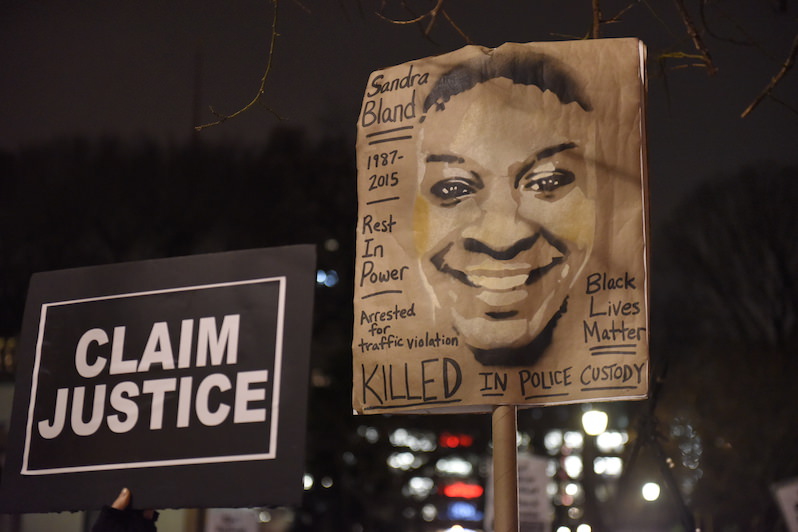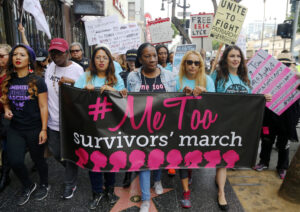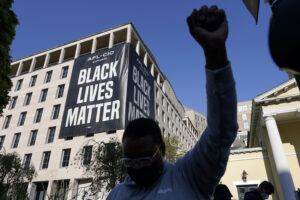Today’s Causes Veer Toward Powerful Tweets, Away From Powerful Leaders
The protests of older generations—the 1960s civil rights movement, for example—were led by movement icons such as Martin Luther King Jr, but now the reach and power of social media give virtually everyone the chance to become a movement leader or influencer The protests of older generations—the 1960s civil rights movement, for example—were led by movement icons such as Martin Luther King Jr . Activists gathered in New York City in December for a candlelight vigil in memory of Sandra Bland. (a katz / Shutterstock)
Activists gathered in New York City in December for a candlelight vigil in memory of Sandra Bland. (a katz / Shutterstock)
When we think of early American protests, we think of the Boston Tea Party of 1773. During that historic demonstration, the colonists destroyed a large shipment of tea in a bid to end the British East India Company’s monopoly on the tea trade, a move that led to the American Revolution and the colonies’ independence from Britain. We might also think of the legendary but unsuccessful 1831 rebellion led by Nat Turner in Southampton County, Va.
The first of these two uprisings was an act of defiance (i.e., throwing tea into Boston Harbor) that eventually brought about structural change: the transformation of a colony into an independent nation. The second was an act of defiance (i.e., the killing of slave masters) that became an iconic symbol of resistance to the cancer of slavery.
Like these two pivotal protests, subsequent movements before the 21st century — from the abolitionists and early feminists to the labor and civil rights movements — were efforts to accomplish structural change as well as to push back against the oppression of a minority. In addition, these movements were typically led by singular figures such as Samuel Adams and Nat Turner.
But fast-forward to 2016, and we see protests that have become less binary, more dynamic, more open to global participation, and more subject to endless and concentrated critique.
Dynamism
Although the movements of older generations — the 1960s civil rights movement, for example — were associated with figureheads such as Martin Luther King Jr., contemporary protests allow everyone on social media to become a movement leader or influencer. An online campaign started by virtually anyone — and in some cases, even a single profoundly worded tweet — can bring about small-scale changes within hours.
Recall Genie Lauren, who launched a Twitter campaign to stop a juror in the George Zimmerman case from getting a book deal. Lauren succeeded in her effort: Within six hours, according to Dylan Stableford of Yahoo! News, the literary agent representing Juror B37 had dropped the book project.
Though Lauren did not solve the structural problem of racism, she did completely halt at least one attempt by the publishing industry to exploit the tragic death of Trayvon Martin, whose death is now a symbol of the nation’s racial disharmony.
Global Participation
Anyone in the world with access to the Internet could have participated in Lauren’s campaign — or in any online campaign on any other issue. One hundred thirty million people (and counting) are taking action on some issue of concern, according to the banner of the protest website Change.org.
Given the sheer volume of information available and the wide reach of social media, protests are no longer about one voice or leader shepherding the masses to a singular truth, nor are they even about a singular truth championed by a singular racial grouping or around a singular philosophy.
They are about a collective global intelligence engaging in a daily process of voicing, reviewing, correcting and changing course as it works to end injustice in small chunks via Twitter, Facebook, Instagram, Tumblr and other portals (and on the streets, where needed), rather than primarily through regional, on-the-ground demonstrations spearheaded by one or two messiahs.
Pushback
In addition, the act of challenging and cross-examining each protest through those same social media channels has become part and parcel of protest culture, forcing modern-day activist leaders to examine their stances from all sides rather than proclaiming their views as gospel and expecting the masses to coalesce around those views.
The culture of constant pushback forces protesters to sharpen their ideological frameworks. It is a process of ideological fragmentation, whereby the ever-churning social media machine compels every political movement to face the biting ironies of its own tenets.
One example of this occurred when the tea party movement of our time claimed to be protesting fiscal policy (more specifically, on government handouts and the use of Medicare), and the social media machine pushed back. Tweeters, Facebookers and journalists like Matt Taibbi gave us a snapshot of what the tea party actually represents: “elderly white people in Medicare-paid scooters, railing against government spending and imagining themselves revolutionaries as they cheer on the vice-presidential puppet hand-picked by the GOP establishment.”
A second example of the pushback culture occurred in response to the Black Lives Matter movement and its accompanying hashtag, which was almost instantly met with an #AllLivesMatter hashtag.
While proponents of the #BlackLivesMatter hashtag made the important point that black male victims of police brutality matter, social media made the equally valid point that the lives of abused children matter, the lives of women who are raped matter, and so on.
Black Lives Matter proponents then pushed back against All Lives Matter, arguing that the isolation of victims by race does not prevent the isolation of victims by gender or age and that black lives can be highlighted even if children’s lives and women’s lives also matter. Moreover, the phrase “all lives matter,” they contended, is just an attempt to direct focus away from very real racial disparities. The All Lives Matter proponents then responded again, saying that the focus on black lives uses the same problematic emphasis on race that causes undue racial division in the first place. If each of these groups’ lives — black lives, raped women’s lives, children’s lives — matters individually, doesn’t it all add up to them “mattering” collectively?
As is clear from the back and forth, the social media machine vets and challenges every protest without exhaustion and forces every protester to examine all sides of his or her viewpoint before attempting to present it as unimpeachable truth.
A third example arose with the movement against the police harassment of African-American males via the practice of “stop and frisk,” when African-American women and women of other ethnicities on social media pointed out that they are often stopped and sexually harassed on the street by the very same African-American men — and on a much more frequent basis.
According to a 2014 study, 65 percent of women had experienced street harassment. In contrast, only 53 percent of black men had been stopped by the police. Thus, men harass women on the street significantly more than police stop black men. In response, blogger Feminista Jones started #YouOKSis, an anti-street-harassment Twitter campaign for women. Rob Bliss Creative also posted “10 Hours of Walking in NYC as a Woman,” a YouTube video on street harassment that has garnered almost 42 million views.
Implications for the Future
Social media, with its nearly unlimited access to data and information, spawns protests but then argues with and protests those protests over and over again.
I believe that such endless cycles of debate and the culture of pushback culture are healthy (trollers in comments sections notwithstanding) because they reflect a deepening level democratic engagement. I only wish that this ideological fragmentation that it represents would be extended to the American political system, which remains a binary two-party system.
I am far from excited about the slight differences between the Democratic and Republican fields’ positions on many issues this election year. I am saddened that the only reason I will be voting for the Democratic candidate — whoever that person turns out to be — is to try to prevent the Republican from gaining power and earning the right to appoint right-wing Supreme Court justices who would cause irreparable damage to our society — a society that has become increasingly refined and self-critical due to the influence of social media.
Your support matters…Independent journalism is under threat and overshadowed by heavily funded mainstream media.
You can help level the playing field. Become a member.
Your tax-deductible contribution keeps us digging beneath the headlines to give you thought-provoking, investigative reporting and analysis that unearths what's really happening- without compromise.
Give today to support our courageous, independent journalists.






You need to be a supporter to comment.
There are currently no responses to this article.
Be the first to respond.